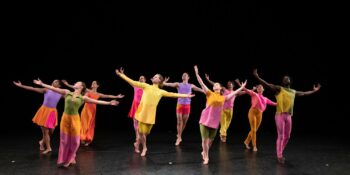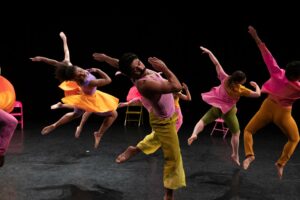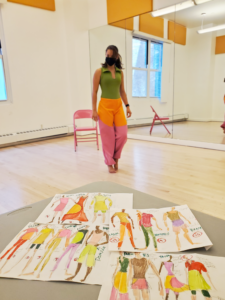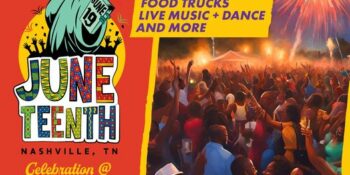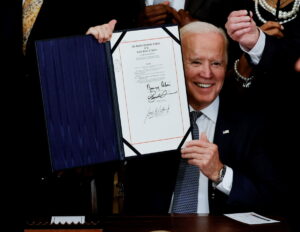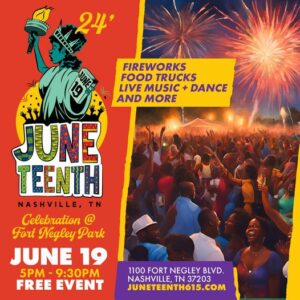Kindling Arts Festival 2024 – a selected works review
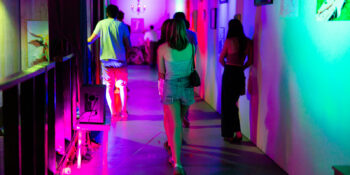
In its seventh year of being the main showcasing platform for performing arts in Nashville, once again, Kindling Arts Festival’s focus was on a broad theme of immense social value and sense of urgency: “Imperfections.” In a competitive society that constantly pressures us for progress and success, it is extremely important to propose an artistic confrontation of the opposite: how can we reshape the way that we view our imperfections, be blunt about them and embrace them instead of constantly and ineffectually trying to change ourselves to fit the norms and perpetuate an exclusive living environment?
As the soundscape during Amy Bell, Patriq James and Brandon Johnson’s dance trio (showcased within the Unclassified Performance Art program) suggests: “Art is both a mirror to the society and a hammer to shape it with.”
As a performance maker sitting in the audience, I took great pleasure from observing the audience’s reactions to what was being presented to them on stage, and I must say, I heard some contagious laughter and saw some down pouring of tears in the various performances I attended during this year’s edition. This creation of room for performing arts to become catalysts of dialogue and social change, alone, is a great success for a festival with a fixed theme and wide presence that puts the audience entertainment at the center of their work.
I purposefully chose to attend performances that were predominantly of a smaller scale and gave visibility to up and coming voices of experimental approaches to theater and performance, such as Bend & Break: Performance Art Studio Sharings, but I also attended works by already established and returning names such as Asia Pyron’s PYDANCE and Jennifer Whitcomb-Oliva’s solo performance within the Unclassified showcase.
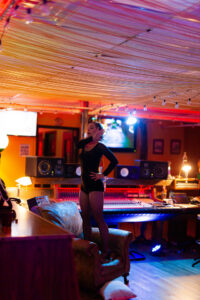
Below I will look into some of the performances that I was able to attend, feeling a sense of missing out on all the others that were physically not possible to be at due to overlapping schedules. On top of preparing my debut in the U.S. with the stage reading of my play What Sprouts First When the Earth Burns? (At Global Education Centre), I couldn’t wrap my math around to capture twenty-two performances in seven spaces in four days!
Murder of Crows by PYDANCE, choreographed by Asia Pyron who also serves as its director, set the labyrinthian stage for an immersive experience at the Welcome to 1979 vintage geared recording studio. The audience was invited to roam around the two-floor oak wood smelling space, to follow the actors around different rooms, to observe their textual unveilings and dance moves from various angles. There was no seating assigned so it was likely to be in proximity with the performers, sometimes realizing we were occupying the space of what was choreographed to be their next performance move. For those that have experienced Sleep No More’s Macbeth themed immersive promenade at McKittrick Hotel in NYC, this evoked a similar experience, although within the tight choreography of Murder of Crows, there seemed to be very little room left for live improvisation and interaction with the performers. In an almost satirical tone, Murder of Crows is about trust and secrets, about prestige and an effort to climb high up the ladder of success, while being confronted with anxieties and fears of not being good enough, not being enough. Asia Pyron and PYDANCE, names one should look out for whenever the opportunity is given, surely put dance pieces within a social context, oftentimes served in a very blunt and intensive way such as in their God’s Country which was showcased at OZ Arts during Brave New Works Lab.
30 imperfect plays in 60 perfect minutes, by Where House Ensemble Theater, also a participatory performance, brought 30 rough drafts of approximately two-minute sketches, the order of the interpretation of which was chosen by those who were able to shout the loudest in the audience. Ultimately, all sketches were performed with mighty skill and coordination. The scope of social issues that the sketches unveiled varied from romantic to family to interpersonal relationships, oftentimes provoking laughter due to the familiarity with what was being portrayed. However, moments of deep silence and long tears were also present among audience members, none of whom I believe was spared from being emotionally untouched.
Again, this year, Kindling Arts Festival had made room for visual arts and multimedia as well as workshops which were free to attend. The parties haven’t been missing from the agenda either! I managed to attend Look What the Tide Brought In, a celebration of Asian American Pacific Island (AAPI) films, an invigorating film program curated by Josh Inocalla. The film/video selection which included works by Josh Inocalla, Erik Sharpnack, Randa Newman, Amanda Adams, AJ Johnson, and James Kyso, aimed to emphasize the stories of the API artists in the U.S. through the lens of the richness that their diverse experiences bring to communities where they live and the country at large.
A similar goal was set for Unclassified, a selection of works by Sara Beth Go, Grandma Fun, Chris Strauss and Jennifer Whitcomb-Olivia staged at Darkhorse Theater. Sara Beth Go utilized stop-motion to parallel her vulnerable yet humorous songs and storytelling, Grandma Fun invited us to rejoice in her The Jungle Jalopy Presents: Hot Dog Lady Spectacular Freakshow hotdog dance recital, producing an amusing sentiment through red nailed hotdogs dangling from her intimate areas and fingers, while dancing to various rock and roll love songs. Chris Strauss’s bantering Nutcracker parody queerified their talents as a dancer and piano player while Jennifer Whitcomb-Olivia’s heart-wrenching solo that examined the various spectrums of being in and with the world as a neurodivergent individual brought both sighs of empathy and crackles of laughter.
At Darkhorse Theater, I also attended the neo-burlesque, all black, mystical garden of Fleur Noire featuring Eden L and established DJ Afrosheen. While the show started by stating the fact that the black woman is the most marginalized, underserved member of the U.S. society, unfortunately, due to a lack of critical approach towards the objectification of women’s bodies, it reduced the brave performers into what it aimed to criticize, and it reinforced their obstructive positions.
Bend&Break Performance Art Studio Sharings showcased at Global Education Center included the above-mentioned contemporary dance trio consisting of Amy Bell, Patriq James and Brandon Johnson, Delaine Bobbs & Sandy Perez’s push and pull dance of placating and antagonizing forces and Clover Tipton’s witty performative reflection on the artificiality of assemblage. In an avant-garde usage of irony and naturalist stage presence, Clover utilized the assembling of high end rose bouquets to delve deeply into their correspondence with personal reassembling as a means to embrace self in opposition to what comes to us as a given (by our family and surroundings); to further question multiple facets of this friction, including the mention of the underpaid workers in Brazil who have cultivated the mesmerizing yet scentless red roses.

The festival concluded with performances at Begonia Labs. Through a ritualistic mystique reflecting on the fleeting nature of spiritualism, Sylas & Bunny Nunn’s: Let loose a terrible cry– brought an otherworldly ritualistic atmosphere, accompanied by rapturous video installations by Bunny Nunn. The looped cello sounds added a mellifluous layer to Sylas Nunn’s rippled reading under a lush red color.
Following the above, IMGRNT’s: War & Beat (in A natural minor) – brought to stage a god-like creature’s power and might covered in fabrics that reminisce nature and blood. With a spike mask and high tempo techno music, IMGRNT views through ”the lens of alien invasion, unapologetically celebrating the immigrant experience”. Taking pride in the status of an immigrant, otherwise, othered under the legislatively defined term ‘alien’, brings a fresh and empowering perspective.
I believe that aside from advancing in their careers, artists have a tough role to challenge and forward the art forms in the mediums that they practice. Despite all the hard work put into realizing these thought provoking and accelerating performing artworks, due to the ephemeral nature of performing arts, they have a limited longevity. To ensure the acknowledgement of the labor and engagement of these artists and at the same time to offer a more disruptive performative art scene to a wider and not necessarily artistic (coming from the art world) audience, if not all, at least some of these performances should become part of the repertoire in various permanent stages in the city. Kindling Arts has initiated an attempt to do so by bringing back the revised East Nashville Facebook Page- The Musical by Emma Supica and Cherry Bomb from last year’s edition (August 10th at Riverside Revival), and I truly hope that this support of the local artists expands as the festival grows!
(Note: Photography from the event is still being processed, check back for updated photos!)
New Release from Joyous Records
Sofia Goodman’s ‘Receptive’ and the Ideal Character

Human character, its content, strengths, failings, hypocrisy, depth and intimate shadings have long been the subject of artistic, and particularly musical, expression. It is said that the contrasting themes of the old symphonic first movement forms were meant to show the contrasting sides of a single individual. Similarly, in the song-cycle tradition, intricate depictions of different sides of a character were often an important expressive goal. At their best, character depictions in music are tellingly inward-looking for the artist (and perhaps listener’s) character, but at their worst, they are a mere excuse for creating a pastiche of genre. Music City’s Sofia Goodman’s newest release, the remarkable Receptive, while quite diverse in genre, lies firmly in the former group.
Receptive is a collection of eight pieces for octet that is organized around the stages and aspects of receptiveness, her “core value,” defining her character and investigating ours as we listen. Throughout the album, the musicianship in the octet is top notch—fluent, expressive with restraint and often immeasurably poignant. Goodman has recently received a lot of hype on the Music City Jazz Scene, and this album justifies that excitement.

The album opens with “Trust” which, reflecting the song’s title, features a tightly blended melody and an introspective improvisation from Blaise Hearn (trumpet) whose line and color are more mellow than brassy. It is an entry into Goodman’s sonic world, and here the ambiance and timbre can carry as much, if not more, interest than meter, mode and formal articulation— the sound of a rainstick for example, or a cymbal roll, are identical in formal function but differentiated in expressive color. In the second track, “Allow” Jovan Quallo’s flute solo evolves through waves of continuing variation (a kind of melodic thread that seems to run through the collection). While Lopez’s and Goodman’s solo felt almost obligatory, Leland Nelson’s (bass) bowed and pointed coda took my breath away. This is one of the other wonderful things that unify the album–transitional passages between tracks.
Raised in Boston, Goodman came on the scene there through Berklee, studying percussion. You can hear this background in the music’s constant rhythmic interest and an intriguing confidence heard in the arrangements. However, her melodies are even richer, probably a result of her time studying composition at Belmont University here in Music City.
The third track, “Channel” features Desmond Ng’s (trombone) surprisingly patient and melodic solo work whose eloquent diction (it’s almost a recitative) leans against Goodman’s driving rhythm section, breaking into a gentle Hispanic dance here and an equally traditional backbeat there, channeling the melody through these stylistic transitions.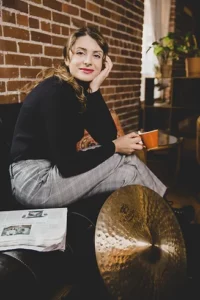
The liner notes mention the “noir swing” of “The Space Within,” but I think the terms should be separated by a comma (re. noir, swing!). The bisectional head’s front delightfully suggests film noir’s flashbacks of dramatic development in staccato punches until that swing beat actually falls headlong on the back end. Goodman’s solo that culminates the song is wonderfully garish, leading, quite unexpectedly, to the track’s underwater coda; it’s as if they had fallen into a pool and kept playing, or did we fall into the pool? In anycase, the experimental gesture works somehow. This leads to the abstract, and almost free, fourth track “Socket.”
“Presence” returns to a beautiful melody that, it seems to me, communicates the idea of presence as being “in the moment.” Nelson’s solo is again exquisite, an expeditionary adventure that remains ever in the pocket. Dan Hitchcock’s saxophone solo in “Gratitude” is resoundingly virtuosic even as the track sets up the finale like an upbeat. The finale, “Receptive” completes the album providing closure to the grand sweep of the concept, framing out and unifying the album’s architecture in a celebration.
Listening to the entire album in one sitting makes for a wonderful moment away from the chaos and enriches the experience over listening to any individual track in isolation—in this way it is successful as an album. Does anyone listen to entire albums in one sitting anymore? However, the album, being true to the concept, is blatantly (and perhaps too) optimistic in nature. There are a number of examples of stylistic diversity in Goodman’s concept and composition, but each reaches for a related, positive expression (with the possible exception of the abstract “socket.”) After the collection, as a listener, I longed for a little more expressive contrast. I’m thinking of the forward aggression of Goodman’s “Sea Legs” from Secrets of the Shore, or check out “Navigator.” One wonder’s how Goodman might have approached the expression of some of the darker and uglier sides of human character. That said, the universe of Receptive is an idealized world we would all be lucky to visit.
In sum, by being in Music City, Goodman has managed to surround herself with a group of fantastic musicians capable of articulating her ideals in a beautiful clarity; it is a great album from a rising star on the scene. Receptive will be released by Joyous Records on July 26 and may be purchased (or preordered) through Goodman’s website here: https://www.thesofiagoodmangroup.com/. The Sofia Goodman Group will be appearing at Analog in Nashville to celebrate its release on July 29th.
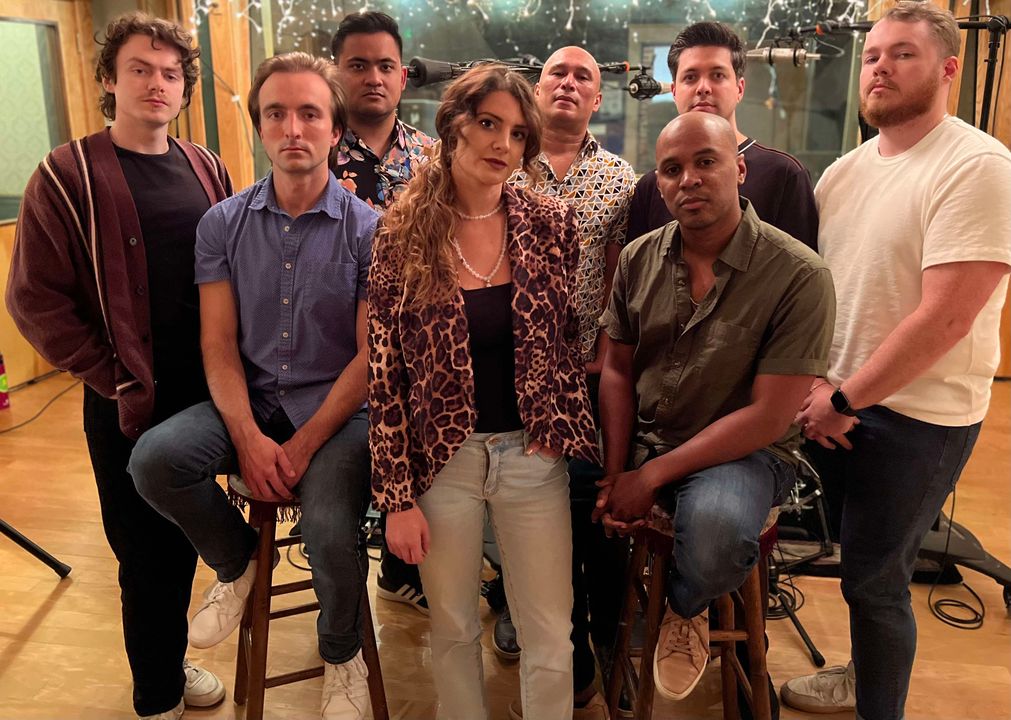
Lake Street Dive at Ascend
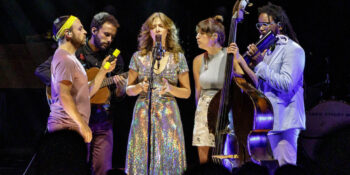
Lake Street Dive is bringing a fusion of several styles including pop, jazz, funk, soul and many more. Bolstered by Rachael Price’s strong and powerful vocals their music tells stories, remembers good times, warns of a grim future and is rocking venues throughout their tour, including Nashville’s own Ascend Amphitheater. After first listening to some of their music before the concert I was concerned about how it would translate to the stage–would there be a lot of energy or would it be a more mellow concert. I was pleasantly surprised at their energy and aura on stage. They were effective and powerful using elements such as stage design and well thought out lighting to assist them. The lights would often accent important beats and the clever use of the backdrop lights to reflect what album a song was from or impact the mood they wanted to portray was a nice touch.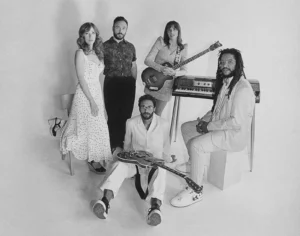
In my mind the most impressive part of Lake Street Dive is that the group possesses so much talent, especially in their guest artists which included a horn section made up of a Brooklyn Jazz group called the Huntertones. Bridget Kearny was specifically of note playing an upright bass for most of the show. This choice added a lot of effects and extended techniques, such as the unique sound of an open string rattling on the wood, that benefited the group strongly. Akie Bermiss was killer on the keys and had an astounding voice that complimented Rachael Prices sound well, I only wish he sang more. Akie did play his choice song, a Shania Twain cover, “You’re Still the One” which gave Rachael a break but still stunned the crowd with his incredible vocal skill. Drummer Mike Calabrese held it down the entire show and got to show off his songwriting chops when they played “Making Do” which reflected on what the next generation will have to deal with if we continue our current trajectory of carbon emissions. The band has taken their own steps to be more ecofriendly as a band on this tour including selling water bottles where all proceeds go to philanthropies dedicated to slowing climate change. James Cornelison played a lesser role providing solid guitar backgrounds to the group and taking an occasional solo. Finally, Rachael Price continued to leave fans in awe at her thundering yet calming voice.
The band opened with the title track to their new album “Good Together” after entering from their curtained backdrop. At first when they opened with this song, I thought they had overstepped. This is one of their higher energy songs and if this is their opener I wasn’t sure how they were going to keep the energy flowing for the entire concert. I was pleasantly surprised as they mixed in songs from previous albums to accompany their new songs. They followed up “Good Together” with a personal favorite, “Hypotheticals”. With these two songs, the beginning of the concert was off to a very good start.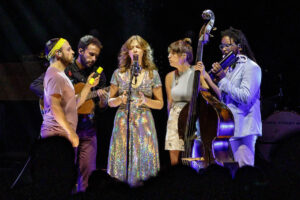
One of my favorite parts of the concert was the acoustic set. Though acoustic sets are almost a given at just about any concert you go to, Lake Street Dive did it in their own way and it was incredibly effective. They all gathered at center stage and crowded around a single microphone with acoustic guitar, upright bass, tambourine and what looked like a Melodica. The bright and colorful lights they were using were replaced with just a few spotlights lighting up the small section of the stage they were taking up. Here they played a few songs but notable were the title track of their album “Side Pony” and Bridget Kearny’s “Neighbor Song”. According to the band they had made a pact to never play “Side Pony” again but after hearing people yell for it at concerts for a while they brought it back to the setlist for this tour. “Neighbor song” was nice and reflected on the packed living conditions and its effects on human life in places like New York City.
Many of the songs performed had heartfelt messages from either personal experience in the band, worries for the future or a culmination of the two. Including “Twenty-Five” off their new album—a record about Rachael’s first “real romance” in a local waffle house which I found funny. They closed out their main set with three high energy songs. “Party on the Roof” was fun, and the band took effects into their own hands adding a coordinated jump off of part of their staging following the solo break back into the chorus. Around this time in the concert Rachael spoke to the crowd which had been sitting for most of the concert and said that “If there was a time to stand up it’s now” but later added that it was “not a summons… you can choose.” I found her sarcastic humor hysterical, and it only added to my enjoyment of the concert. For “Dance With a Stranger” they brought some “strangers” on stage to dance during the song. This was a fun and genuine experience and had a really nice effect on the song. They closed their main set with “You Go Down Smooth” which seems like a song written solely to show off Rachael’s vocal ability and I’m totally here for it.
Of course, this wasn’t the end of the show they came back on and performed their cover of Daryl Hall and John Oates “Rich Girl” to a crowd that was singing loudly with them. This cover is by far their most popular on their list of covers from the “Fun Machine” EPs. They finally shut it down with one of the most popular songs “Good Kisser” which was an incredible closer with high energy that left the crowd satisfied but still wanting a little more. Overall, the show was incredible and surprised me in many ways. The quality of the musicians was top notch, the energy far surpassed my expectations, and there didn’t seem to be any hiccups. Rachael, Akie and Mike interacted with the crowd between songs which made me feel like we were a part of the group all along. Their fusion of styles turned into something great that night and I am looking forward to another opportunity to see them soon!
From the (not so) Far-Flung Correspondence:
Columbus, Georgia’s Ma Rainey House and Museum: A Testament to the “Mother of the Blues”
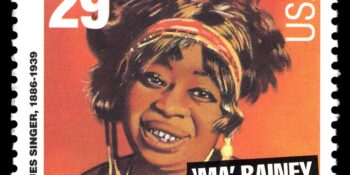
This past June, I attended a music history conference in Columbus Georgia, where a significant portion was dedicated to exploring the blues through legendary singer Ma Rainey’s life and legacy. This conference’s segment culminated in a special tour of Rainey’s historic former home, and of other adjacent landmarks, offering a captivating glimpse into her life and the rich blues heritage of the region. The Ma Rainey House, showcases local blues history, fascinating exhibits, and authentic artifacts, providing a deeply immersive experience.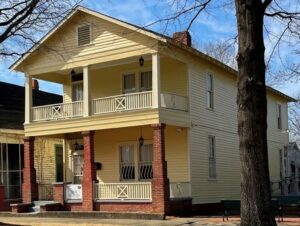
Gertrude “Ma” Rainey (Gertrude Pridget) played a pivotal role in shaping the blues idiom, bridging the gap between Bessie Smith’s classic-style blues and the “country blues” tradition of the Lower Chattahoochee River Valley. Journalist Chris Albertson aptly described Rainey’s impact, noting that she “introduced the earthy spirit of country blues to the stage, giving a tinge of the polish that characterized the work of her former collogues.”[1] Beyond her musical prowess, Rainey was a complete persona, far more than just a blues singer. On stage, she commanded attention with her powerful voice, delivering songs about love, heartbreak, and a woman’s determination, infused with a sharp wit and playful humor. However, beneath the surface, Rainey’s lyrics and music often delivered meaningful commentary about everyday life, far removed from the superficiality of the entertainment world. [2]
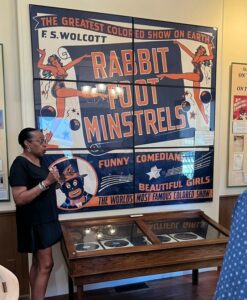
Ma Rainey’s illustrious career, marked by numerous affiliations and accomplishments, far surpasses the scope of this brief overview. Her journey to a recording contract with Paramount began on the Chitlin’ Circuit, a vital network of performance venues that embraced African American entertainers during the Jim Crow era.[3] In 1904, she began part of her three-decade touring career with F. S. Wolcott’s Rabbit Foot Minstrels—where she met William “Pa” Rainey—and later Tolliver’s Circus and Musical Extravaganza. Her rising fame helped secure a five-year partnership with Paramount, during which she recorded over 100 of her original compositions alongside some of the most celebrated musicians of the era. In 1935, Rainey retired to her hometown, moving into the house she bought on Columbus’s 5th Avenue.
Several esteemed organizations have recognized Ma Rainey’s enduring influence through numerous prestigious honors. The Blues Foundation inducted her into their Hall of Fame in 1983 and the Rock and Roll Hall of Fame in 1990 (Bonnie Raitt delivered her induction speech). Her native Georgia celebrated Rainey’s legacy by inducting her into both the Georgia Music Hall of Fame in 1992 and the Georgia Women of Achievement in 1993. In 1994, the U.S. Postal Service honored her contributions with a commemorative stamp, now displayed at the Ma Rainey House. The National Academy of Recording Arts and Sciences further acknowledged her monumental impact with a posthumous Lifetime Achievement Grammy Award in 2023, which is also on display. Additionally, Ma Rainey’s life was depicted in the 2020 feature film, Ma Rainey’s Black Bottom, directed by George C. Wolfe and Viola Davis playing Ma Rainey.
The Ma Rainey house stands as a testament to the love and unwavering dedication of the community to preserve Rainey’s important legacy in the very place where her life and career began. By the turn of the millennium, her former residence had fallen into disrepair and abandonment. However, in 2005, a determined effort arose to purchase the house and its surrounding property. The goal was to restore the structure to its original state, meticulously recreating the atmosphere of Rainey’ s life with its walls. The restoration included replicating details like paint colors, floral wallpaper, and even acquiring authentic pieces of Rainey’s furniture and other important belongings, including her piano, vinyl record player, and Victrola radio. Today, the house is festooned with captivating, curated displays of historical artifacts, photographs, and ephemera, offering visitors a glimpse into the life and times of the “Mother of the Blues.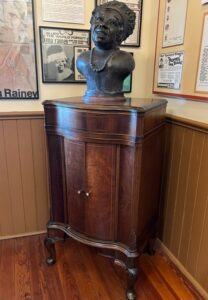 ”
”
Important to mention, our time with museum director Florence Dawkins was truly educational; her passion for her role in creating and oversight of the museum touched all of us there that day. The house is part of Columbus’s Parks and Recreation Department and located at 805 5th Avenue, Columbus, Georgia 31901. Tours are offered by appointment only: Monday–Friday 9:00 a.m.–3:00 p.m. | Saturday 10:00 a.m.–3:00 p.m. | Closed Sunday. Phone number: (706) 641-5933. Due to space constraints, groups of over six (6) should make reservations in advance. Groups will be taken through the museum six (6) persons at a time. The website is: https://parks.columbusga.gov/parks/ma-rainey-home. If you find yourself near Columbus, Georgia or if you are looking for a weekend jaunt, the Ma Rainey House is must-see.
Complementing the Ma Rainey House, the Columbus Museum is currently hosting “Crossroads: Chattahoochee Valley Blues and Folk Music,” an exhibit exploring the rich musical heritage of the region, including Ma Rainey’s connection to the Chattahoochee River Vally Blues. What makes this exhibition truly unique is its entirely student-curated nature. Under the guidance of musicologist Dr. Reba Wissner, students of the Public Musicology Certificate program at Columbus State University’s Schwob School of Music have meticulously crafted a fascinating display, showcasing their expertise in music history and cultural preservation. The exhibit will be on view until further notice. The Columbus Museum: 1251 Wynnton Rd. Columbus, GA 31906. https://columbusmuseum.com.
Last, I would be remiss if I did not mention Columbus’s remarkable restoration of its Liberty Theater, where Ma Rainey performed several times. Built in 1924–25, the Liberty Theater was the first in the area to welcome African American audiences during the Jim Crow era. Initially focused on cinema, the theater also boasted a stage that hosted an array of trailblazing black artists like Marian Anderson, Ella Fitzgerald, Ethel Waters, Lena Horne, and Bessie Smith. The Liberty also saw performances by legendary bands like Duke Ellington’s, Cab Calloway’s, and Fletcher Henderson’s. After closing in 1976, the Liberty remained abandoned until the Columbus Consolidated Government took ownership in 2023. Now, the Liberty Theater and Cultural Events Center stands as a testament to the rich legacy of black artists who performed there. While final renovations are underway (as of June 2024), visitors can consult the center’s website information about future events. 813 8th Ave. Columbus, GA 31901. (706) 604-1331. https://www.columbusga.gov/libertytheatre.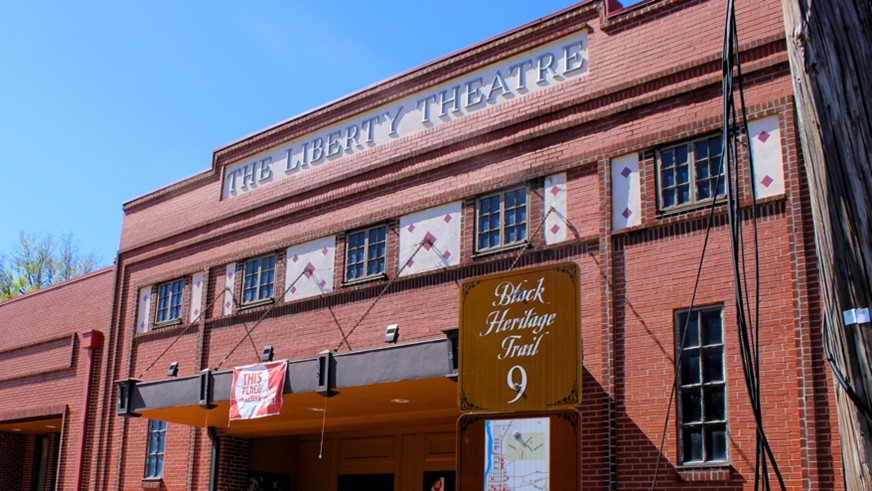
[1] Chris Albertson, “Ma Rainey,” Rock and Roll Hall of Fame. Accessed: July 13, 2024. https://rockhall.com/wp-content/uploads/2024/03/Ma_Rainey_1990.pdf.
[2] Ed Ward, “The Story of the Chitlin’ Circuit’s Great Performers,” NPR. Accessed: July 13, 2024. https://www.npr.org/2011/12/20/140596530/before-rock-n-roll-the-chitlin-circuit-performed.
[3] Ed Ward, “The Story of the Chitlin’ Circuit’s Great Performers,” NPR. Accessed: July 13, 2024. https://www.npr.org/2011/12/20/140596530/before-rock-n-roll-the-chitlin-circuit-performed.
One of MCR's Drama Specialists goes to a Conference:
“Navigating Waters: From Oppression to Liberation”- the 27th Pedagogy and Theater of the Oppressed Conference

For those who view theater as a tool for empowerment and social change, Pedagogy and Theater of the Oppressed (PTO) are not foreign terms, however, I wouldn’t want to assume anyone’s knowledge, therefore I’ll start with a brief history.

Pedagogy of the Oppressed was coined by the Brazilian pedagogical philosopher and liberatory educator Paulo Freire who believed that education is a reciprocal process and a political act that enables the humanization of the oppressor and the liberation of the oppressed.
In the ’70s, the Theater of the Oppressed was founded by the Brazilian theater practitioner, educator, and political activist Augusto Boal who was radically influenced by the theories of critical pedagogy that Freire developed during the 50’s and the 60’s. The Theater of the Oppressed consists of various practically developed theater methodologies that Boal often organized into systems of trees. Within this metaphorical context, the major branches of his styles and techniques are Forum Theater, Image Theater, Invisible Theater, Rainbow of Desire, Newspaper Theater and Legislative Theater that involve audiences as ‘spect-actors’ or critical and active participants in discussing, representing, deconstructing, and reconstructing the social issues they face, thus building proactive communities.
Both Freire and Boal have a history of engagement in the U.S. academia as well as are advocates of their pedagogical and theatrical methodologies here. Although the two are from Brazil, due to bitter histories of being imprisoned and exiled for their ‘threatening’ practices, the first and only time they co-appeared on a public platform to reflect on liberatory education was at the Second Annual Pedagogy of the Oppressed Conference in Omaha, in March 1996.
The fact that the Pedagogy and Theater of the Oppressed Conference held its 27th annual gathering at Eckerd College in St. Petersburg, Florida this end of spring, is a testament to the impact of PTO in theater making as well as social engagement across the U.S.
The conference as well as the pre and post workshops related to it are organized by the PTO board members and volunteers who do this out of sheer love and belief in Freire’s and Boal’s discoveries. Some of the workshop leaders are Boal’s students, translators and even his son, Julian Boal, who held a three-day post conference workshop on ‘Forum Theatre: Devising and Jokering.’ While Julian Boal vehemently practices his father’s theater methodologies, he is also probably one of the biggest challengers of them. According to him, his father set a platform, but he wanted the practitioners of the Theater of the Oppressed to forward and adjust his methods to the contemporary needs and not apply them as facsimiles.

This year was my first time attending the PTO Conference and I am restlessly eager to continue following this critically important event in its future conventions. The theme of the conference “Navigating Waters: From Oppression to Liberation” is defined by the conference organizers (according to their website) as a reference to the contemporary dangers the immigrants face crossing perilous waterways in search of safety and the frontline communities impacted by climate catastrophe. It acknowledges the historical struggles for justice of the enslaved and usurped ancestors and the power of water to connect, cleanse, sustain, and give life.
I went to the conference with the mindset of a devised performance and theater educator and practitioner, wanting to gain a more hands-on practice, which is exactly what the conference offered. While various branches of Boal’s theatrical styles and techniques were presented, the main goal of the workshops provided during the conference was to practice them, undoubtedly the most effective way of learning.
Below, I will mention a few of the workshops and all-conference presentations that I attended, constantly carrying the fear of missing out due to multiple alluring sessions taking place in parallel. It was always a hard choice to decide what to attend, although catching up with other participants who went to different sessions added to the element of socializing and networking.
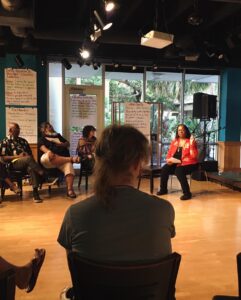
Mark Weinberg from the Center for Applied Theatre in Milwaukee, WI, held a one-day pre workshop focused on exploring and negotiating power as well as relinquishing control. Although these largely heavy weighing concepts were explored, through utilizing Boal’s as well as Weinberg’s own games, the workshop contained so much joy and liveliness which unquestionably are characteristics that come into play through the medium of theater.
During a two-part session, Julie Wells elaborated on her topic ‘Sociodrama: Navigating Oppression in Traditional Children’s games’, a workshop that not only explored the violent aspects of children’s games such as dodgeball, but also recognized the efforts of teachers, often on the edge of burnout, determined to navigate through the complexity of inclusive, compassionate and present-day teaching.
Denver-based non-profit Mirror Image Arts offered an interactive two-part session delving into the pedagogy and praxis of Restorative Theater, a set of tools they utilize for deconstructing, restoration, and healing in schools, detention centers, and professional development.
Another inspiring workshop on the legacy of the freedom fighters in challenging oppressive systems was brought through ‘Practical Approaches to ‘Deep Equity’ and ‘Liberatory Leadership’ with Kaye Craft and Debra Alexander, who among others brought up her activism during the Selma Marches.
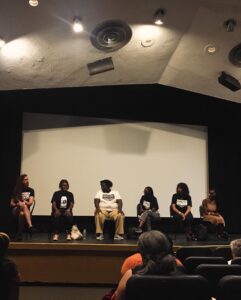
Some of the all-conference sessions included talks with the freedom and safety geared non-profit, Dream Defenders, the pedagogical coordinator of Escola de Teatro Popular, Julian Boal, the professional Latinx theater organization, working at the intersection of Latinx, immigrant, and LGBTQ+ identities, Descolonizarte TEATRO (Desco), to mention just a few.
The conference also offered a great non-formal avenue to meet other practitioners of devised theater and PTO. “This conference is a platform for sharing knowledge, experiences, and building new coalitions”- is what the PTO website states, and it truly is.
Everyone who operates along similar lines in invited to support this initiative by hosting future conferences and/or presenting their work through “proposals for workshops and panels that actively engage participants in practical, hands-on exercises, critical dialogues, and performances; explore stories of resilience, community empowerment, and diverse strategies for understanding and acting in the world”.[1]
I came out of the conference with a lot of hope gained thanks to the conference organizers, presenters and participants, nonprofit organizations and communities, tirelessly working to improve the lives of those in the margins of our society and make their voices, their stories heard. “If your voice is not being heard, then we have a situation of oppression”- said Mark Weinberg during his one-day workshop, and this gives us enough incentive to strive for the opposite.
I feel inspired and somewhat trauma washed, as many of the practices we did (and we did a ton) included recalling situations of power or powerlessness that we have experienced. The exercises and games also had the potential to put us in the shoes of our students, constituents, collaborators, leaders, oppressors, and the conference lecturers were able to foster a safe space for sharing vulnerable stories which were carefully held and sympathetically embraced.
Here’s the Pedagogy and Theater of the Oppressed website which contains more information on how you can engage in the future! I highly recommend it to anyone working in the intersection of theater/performance and community engagement!
https://ptoweb.org
[1] https://ptoweb.org/25443-2/
Nuevo da Music City
Sphinx Virtuosos en el Schermerhorn el 9 de Julio
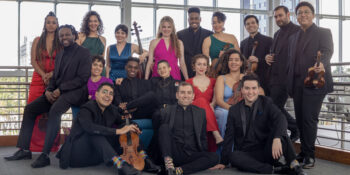
(English Version Here)
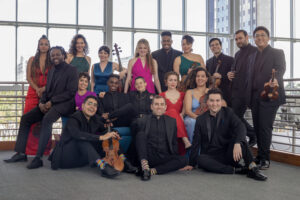
En 1997, el violinista Aaron P. Dworkin buscó “identificar, empoderar y apoyar a jóvenes artistas talentosos y prepararlos para carreras profesionales en la música clásica”. En el último cuarto de siglo, el Sphinx organización ha crecido hasta convertirse en un grupo a nivel nacional que brinda educación gratuita, giras por cuatro conjuntos de talla mundial y una serie de encargos y presentaciones de nuevas obras de compositores negros y latinos. El martes 9 de julio, su orquesta de cámara insignia, profesional y autodirigida, con 18 artistas negros y latinos consumados, presentará un concierto de música inspirado en la obra literaria y las vidas de Julia Álvarez y Langston Hughes.
Las obras destacadas incluyen extractos de la Sonata da Chiesa de Adolphus Hailstork, la Sinfonietta No. 2 de Coleridge Taylor Perkinson, “Generations”, Divided de Jessie Montgomery, así como nuevas obras para los virtuosos de la Esfinge de Quenton Balche (Habari Gani), Javier Farias (Abran Paso) y Andrea Cassarrubios (Herencia). El concierto promete ser un excelente momento destacado del verano, vale la pena asistir, y si conoce a un joven negro o latino con aspiraciones de interpretación clásica, ¿traerlo? A continuación se muestra una interpretación de Divided de Montgomery. Entradas disponibles aquí
Nuevo de Music City
Celebración Sinfónica del Folklore Colombiano en Bogotá

(English Version Here)
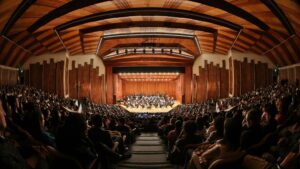
Con una trayectoria de más de 50 años, la Orquesta Filarmónica de Bogotá es un referente a nivel internacional por su amplio programa de música occidental, tradicional colombiana y latinoamericana, así como la fusión sinfónica con géneros como el rock y la salsa. El repertorio que se selecciona para cada temporada es versátil y así mismo es la maestría de sus intérpretes para reproducir el sonido auténtico de cada época y región.
Ha sido un deleite reencontrarme con la fotografía viviente del que fue el primer recinto al que asistí para escuchar a la OFB, el Auditorio León de Greiff. Esta obra arquitectónica, en el corazón de la Universidad Nacional y declarada Monumento Nacional, ha sido escenario no solo de eventos artísticos, sino que ha cedido sus tablas a vehementes discursos de transformación intelectual y social. La reciente renovación del auditorio preservó la esencia en el diseño vanguardista y su calidez acústica, y la orquesta nuevamente demostró el dominio de mezclar sus frecuencias con la estructura amaderada para obtener una amplia paleta de timbres. Otro punto que debo destacar, es que la silletería no se reformó con soportes para bebidas como está ocurriendo en importantes auditorios internacionales. En mi opinión, la combinación de música y comida, es propio de los restaurantes.
Independientemente de las generaciones de músicos, directores y arreglistas que han hecho su carrera en esta orquesta, de la diversidad de su audiencia y de la interacción con las nuevas tecnologías, la experiencia sensorial insignia permanece. En esta oportunidad, el programa tan especial que se preparó para elogiar el privilegio geográfico de Colombia, elevó a un público extasiado que no pudo permanecer sentado. Esta es otra de las cualidades en los eventos sinfónicos que persiste en el tiempo; no es solo la música colombiana o popular la que logra motivar la interacción de la audiencia con la orquesta, el público bogotano por tradición siempre ha sentido un gran aprecio y admiración por la expresión musical occidental. Recuerdo en este mismo escenario una intensa conversación silenciosa entre Johannes Moser y los asistentes, que culminó en un frenesí durante los acordes finales del Concierto para violonchelo No.1 de Shostakovich y el grito de júbilo de los espectadores. Como es costumbre en Colombia, los artistas no pueden abandonar el escenario sin desfilar cuatro rondas de aplausos e interpretar al menos dos piezas en el bis.
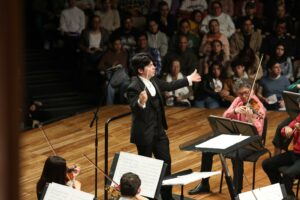
El concierto del 15 de junio, no fue la excepción; un auditorio con lleno total fue conducido paulatinamente en un crucero de emociones por las costas del Pacífico y el Caribe colombiano. En la entrevista que encontrarán a continuación de este artículo, el maestro Rubián Zuluaga, director asistente de la Orquesta Filarmónica de Bogotá, narra cómo en esta sustanciosa selección de piezas se manifiesta una mezcla de ritmos tradicionales con técnicas novedosas en la orquestación como si se tratara de música para cine. El programa es una recopilación de obras instrumentales y vocales escritas para los formatos tradicionales del folklore colombiano, que han sido adaptados con gran fidelidad y creatividad a la instrumentación sinfónica. Esta es una labor que la OFB ha procurado prácticamente desde su fundación para preservar el valor cultural autóctono del país. La colección de álbumes de estudio que le ha merecido a la orquesta dos premios Grammy Latinos, ha sido enteramente dedicada a la grabación de célebres piezas colombianas.
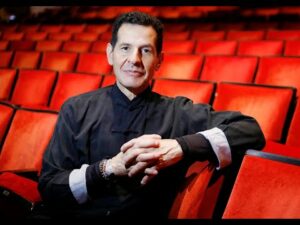
La gala inició con la obra Canción de la Tierra compuesta por Andrés Sánchez Angarita, contrabajista de la OFB. Esta pieza que hace parte del álbum “Salvemos la Tierra Ya” del mismo autor, es una exaltación a la biodiversidad, pero también un llamado a detener la explotación descontrolada de los recursos naturales. En la pieza contrastan secciones de gran densidad orquestal junto con ligeras melodías en las maderas, representando la inmensidad de la selva y las montañas, y la fragilidad de las aves que los sobrevuelan. Durante la interpretación se proyectaron imágenes sobrecogedoras de la naturaleza, así como de los desastres por causa de la industria y el exceso de residuos. Enseguida, Pachito Eché del compositor bogotano Alex Tobar, fue la pieza que suscitó el ambiente de fiesta en el auditorio. Es interesante la evolución de esta canción gracias a sus pegajosas melodías. A pesar de que fue compuesta originalmente en son paisa, género musical folklórico emblemático de la región de Antioquia, Benny Moré en una versión de mambo la catapultó como éxito internacional. Pudo ser este el motivo por el que el arreglista Ricardo Hernández Mayorga haya incluido una sección en la que la obra se desplaza a un salón de baile en la Cuba de 1950.
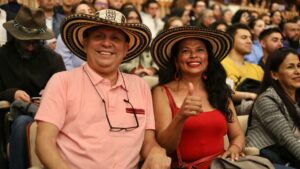
En esta fusión de ritmos colombianos con músicas extranjeras, es propio mencionar el trabajo del compositor Luis Eduardo Bermúdez que, gracias a su interacción con la música tropical y el jazz, le dio un nuevo significado a la cumbia y al porro. El proyecto de ‘Lucho’ Bermúdez se asemejaba a las Big Band de Benny Goodman; las agrupaciones tradicionales se transformaron en grandes ensambles de viento que interpretaban atractivas armonías y apasionados solos de improvisación. Colombia Tierra Querida, una de sus más importantes composiciones y que se ha convertido en el segundo himno del país, es usualmente la obra de cierre en este tipo de eventos. A pesar de que en esta oportunidad la interpretación era solamente instrumental, fue inevitable que el público coreara el estribillo mientras se acompañaba con las palmas y contoneara sus caderas por el hechizo de la cumbia. Así mismo cada familia de la orquesta ejecutó su propia coreografía y las secciones de improvisación en la percusión, infaltables en las músicas del Caribe por su herencia africana, lograron el clímax de la gala.
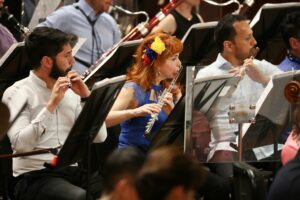
Trasladándonos hacia la región occidental de la Cordillera donde se vislumbra un océano profundo en el que las ballenas jorobadas encuentran cálidas las aguas para su época de apareamiento, el currulao congrega los sabores y saberes del Pacífico colombiano. Los compositores afrocolombianos Petronio Álvarez (1914) y Hugo Candelario (1967) han exaltado la riqueza de estas músicas para que sean apreciadas en todo el territorio colombiano. Desde Bahía Solano hasta Tumaco, la marimba de chonta es el instrumento insignia del folklore del Pacífico; el inigualable sonido de sus teclas nos transporta inmediatamente a esta región. En esta ocasión, en lo que me pareció una combinación entre el vibráfono y la marimba, los arreglos de Mi Buenaventura y Pacífico Amoroso, tradujeron las tonalidades de este idiófono colombiano y recrearon la frescura de los manglares y los arrecifes de coral.
Este festivo encuentro en el que los músicos de la orquesta lucieron blusas y camisas de colores, confirmó una vez más la importancia de divulgar el folklore colombiano por medio del lenguaje sinfónico y contemporáneo preservando su identidad y autenticidad. Para acceder a conciertos pregrabados y transmitidos por la Orquesta Filarmónica de Bogotá visite https://espaciofilarmonico.gov.co/. Mi entrevista con el Maestro Zuluaga se encuentra a continuación,
Coming to the Ascend Amphitheater
Lake Street Dive

Lake Street Dive is the new age brainchild of some New England Conservatory students. Founded in 2004 they provide a melting pot of soul, pop, funk, jazz and folk music. Though originally they were founded as a “free country band” with the intention of playing country music with a similar avant-garde feel found in their current music. They’ve covered a whole range of music including covers of popular pop and rock songs in their “Fun Machine” EP and to their new album full of jazz-pop fun.
Lead singer Rachael Price’s powerful vocals lead this band in their new style direction allowing for the rest of the band to sit behind the vocals and add their own influences discreetly. Drummer Mike Calabreese adds a bunch of metric modulation techniques to add to the groups jazzier style. It feels like at any given moment he could take the song in a completely different direction, often adding beats or changing tempos suddenly for short periods in songs as found in their hit song “Better Than”. Bridget Kearney brings a unique sound to most modern music adding in the upright acoustic bass instead of the more popular electric bass. This choice furthers the bands reach into a jazz influenced style while also complementing hollow textures the instrumentalists often favor. Though I would not say every song has hollow textures, specifically off their Newest album “Good Together” the song “Set Sail” is a great example of this with all members singing together creating a strong powerful sound.
Not only do they draw from jazz but they combine the soul and funk of the Motown era into a lot of their music. They even included a cover of the Motown classic “I Want You Back” by the Jackson 5 on their “Fun Machine” EP. The influence of Motown is seen in almost all of their music not just their covers. Their musical mix doesn’t end there, on their newest album several songs such as “Get Around” and “Party On The Roof” have more of a modern rock influence that differs from some of their past music. Despite this switch, Price’s vocals are empowering as ever.
The influence of all the band members is ever present in the unique writing of their new music. Akie Bermiss said that the song “Better Not Tell You” was originally written from the perspective of the three witches of Macbeth adding an interesting story telling element to the song. Not only drawing influence from classical literature but the music draws from dance pop of the 60s and 70s which adds to their long repertoire of influences.
Overall, Lake Street Dive is an excellent melting pot of musical styles that elevates many of these styles by combining them into new unique music. Their newest album “Good Together” is no exception bringing a new list of songs for all different types of people to enjoy. Lake Street Dive is taking to the road to perform their new album and more across North America. They join us in Nashville on July 13th at Ascend Amphitheater so come hear their music live and enjoy for yourself!

